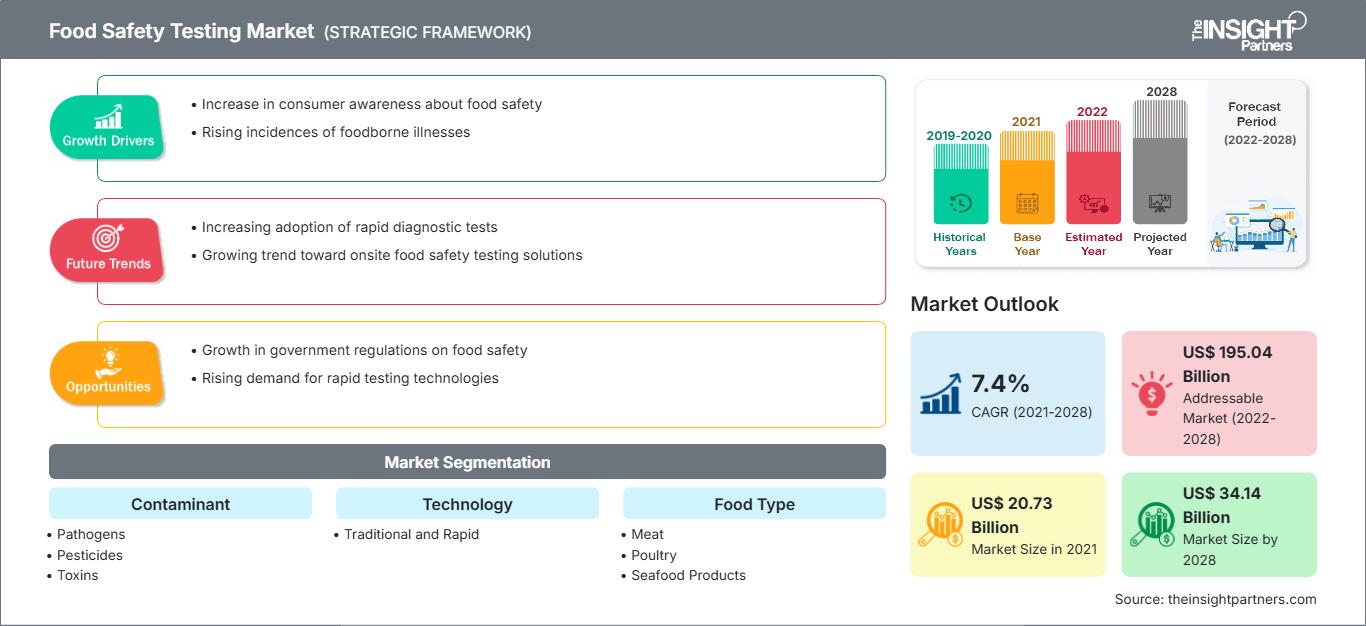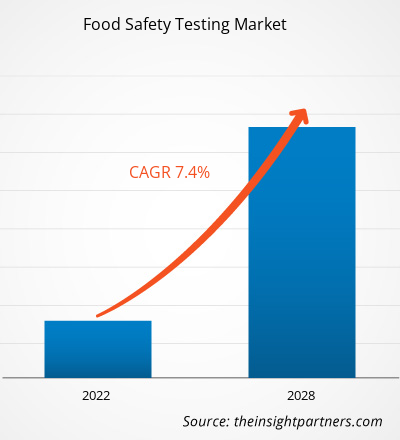2021 年食品安全检测市场价值为 207.334 亿美元,预计到 2028 年将达到 341.425 亿美元;预计 2021 年至 2028 年的复合年增长率为 7.4%。
食品安全检测是对食品及其内容进行科学分析,以获取有关食品物理化学特性、成分和结构等各种特性的信息。这些信息用于确定产品的食用安全性。食源性疾病的流行率不断上升,要求对所有食品和饮料产品进行食品安全检测,以防止健康危害,这促进了食品安全检测市场的增长。根据世界卫生组织 (WHO) 发布的数据,食用不安全食品每年在全球造成 42 万人死亡和 6 亿例食源性疾病。食源性疾病是可以预防的;因此,众多组织和政府牵头协调行动,在多个行业构建具有韧性且强大的食品安全体系。此外,世界银行2018年的一份报告估计,食源性疾病造成的生产力损失造成的经济负担估计每年高达952亿美元。因此,随着消费者对食品安全的认识不断提高以及政府为预防食源性疾病所作的努力,食品安全检测市场正在蓬勃发展。
自定义此报告以满足您的要求
您将免费获得任何报告的定制,包括本报告的部分内容,或国家级分析、Excel 数据包,以及为初创企业和大学提供超值优惠和折扣
食品安全检测市场: 战略洞察

- 获取本报告的主要市场趋势。这个免费样本将包括数据分析,从市场趋势到估计和预测。
您将免费获得任何报告的定制,包括本报告的部分内容,或国家级分析、Excel 数据包,以及为初创企业和大学提供超值优惠和折扣
食品安全检测市场: 战略洞察

- 获取本报告的主要市场趋势。这个免费样本将包括数据分析,从市场趋势到估计和预测。
COVID-19 疫情对食品安全检测市场的影响
消费者意识是全球食品安全检测市场的主要驱动力之一。COVID-19 疫情对市场产生了积极影响,因为消费者和政府都非常关注消费产品的安全和卫生。疫情期间,所有食品和饮料行业都面临挑战,因为 SARS-CoV-2 传染性极强,可能通过食物表面传播。肉类和家禽加工厂在病毒传播方面面临着独特的挑战,因为全球多家工厂的工人都受到了感染。例如,美国卫生与公众服务部在 2020 年 7 月报告称,23 个州的 239 家工厂感染了 COVID-19。报告的病例总数为 16,233 例,其中 86 例死亡。此外,2020 年 11 月,中国报告称,进口的冷冻猪肘样本引发了该国一例新的 COVID-19 病例。食品行业中此类 COVID-19 感染病例引起了消费者和政府的担忧,这推动了对食品安全检测的需求,以降低健康风险。
市场洞察
食源性疾病疫情的出现
食源性疾病具有毒性或传染性。它们可能是由化学物质、寄生虫、病毒通过受污染的水或食物进入人体引起的。食源性病原体可引起使人衰弱的感染,例如脑膜炎或严重腹泻。在某些情况下,化学污染会导致长期疾病,例如癌症,或短期疾病,例如急性中毒。不安全食品的一些例子包括含有海洋生物毒素的生贝类、被粪便污染的蔬菜和水果以及未煮熟的动物源性食品。大肠杆菌、弯曲杆菌和沙门氏菌是最常见的食源性致病菌,每年影响全球数百万人,并导致致命或严重后果。食源性疾病的一些症状包括腹泻、腹痛、呕吐、恶心、头痛和发烧。此外,李斯特菌感染会导致新生儿死亡或孕妇流产。虽然这种疾病的发病率相对较低,但李斯特菌的致死率使其成为最严重的食源性感染之一。霍乱弧菌通过受污染的食物或水感染人类。其症状可能包括严重脱水、大量水样腹泻、呕吐、腹痛,并可能导致死亡。各种海鲜、小米粥、蔬菜和大米都与霍乱疫情有关。因此,为预防食源性疾病的发生,对食品安全检测的需求日益增长。
污染物洞察
根据污染物,食品安全检测市场细分为病原体、农药、毒素、转基因生物等。病原体部分在 2020 年占据了最大的市场份额,而转基因生物部分预计在预测期内将实现最高的复合年增长率。病原体检测是为了消除或减少食源性疾病的发生。消除病原体被认为至关重要,因此在食品生产的每个环节都实施检测过程,以确保食品安全和卫生。一些最常见的可导致食源性疾病的病原体是大肠杆菌、李斯特菌和沙门氏菌。病原体检测可以使用传统技术或新技术进行。传统技术使用传统的细胞培养标准,而新技术包括基于激光或光谱的诊断技术。由于病原体是食源性疾病最常见的原因之一,病原体部分在食品安全检测市场中占有最大的市场份额。此外,由于食品和饮料行业的增长,预计该细分市场的市场在预测期内将增长。
技术洞察
基于技术,食品安全检测市场分为传统检测和快速检测。快速检测部分在 2020 年占据了更大的市场份额,预计在预测期内,同一部分的市场复合年增长率将更高。由于对快速检测服务的需求很高,主要市场参与者正在推出创新产品。例如,2009 年,生物梅里埃公司推出了 TEMPO,这是一种用于对食品中的微生物进行计数的自动化系统。该自动化系统省去了使用微型卡的最大可能数 (MPN) 方法中繁琐的手动步骤。因此,自动化测试不仅可轻松追溯,通量高,而且是手动测试的经济高效的替代方案。此外,该公司还引入了用于食源性病原体检测的重组噬菌体技术,从而缩短了细菌培养至可检测水平的时间。这种快速测试有助于食品制造商节省成本,因为批次的库存等待时间显著缩短。因此,快速测试的多重优势预计将在预测期内推动该细分市场的成长。
食品类型洞察
根据食品类型,食品安全检测市场细分为肉类、家禽和海鲜产品;乳制品;谷物和谷类;加工食品;水果和蔬菜;以及其他。肉类、家禽和海鲜产品在 2020 年占据了最大的市场份额,而水果和蔬菜产品预计在预测期内将实现最高的复合年增长率。肉类、家禽和海鲜产品检测包括污染物检测以及食品掺假检测,即一种肉类掺假到另一种肉类中。产品可能需要检测灰分、脂肪、水分、蛋白质/氮、重金属、农药、抗生素和药物、盐、氯化物以及硝酸盐和亚硝酸盐。由于保质期和产品特性,肉类产品最容易受到污染或出现缺陷。因此,所有国家/地区都强制要求对这些产品进行检测。随着全球肉类、家禽和海鲜产品消费量的不断增长,预计该领域的市场将会增长。食品安全检测市场的一些参与者包括 SGS SA、Eurofins Scientific、Intertek Group Plc、TÜV SÜD、AES Laboratories Pvt. Ltd.、TÜV NORD GROUP.、Bureau Veritas、ALS Limited、NEOGEN Corporation 和 AsureQuality。这些公司为市场提供广泛的产品组合,并在发展中地区开展业务,为食品安全检测市场的增长提供了丰厚的利润。市场参与者正在开发高质量和创新的产品,以满足客户的要求。
报告重点
- 食品安全检测市场中的渐进式行业趋势,帮助参与者制定有效的长期战略
- 发达市场和发展中市场采用的业务增长战略
- 2019 年至 2028 年食品安全检测市场的定量分析
- 全球食品安全检测需求估计
- 波特五力分析,以说明行业中买家和供应商的效力
- 了解竞争激烈的市场形势的最新发展
- 市场趋势和前景以及推动和抑制食品安全检测市场增长的因素
- 通过强调支撑商业利益的市场策略来协助决策过程,从而促进市场增长
- 食品安全检测市场规模在不同节点
- 市场详细概述和细分,以及食品安全检测行业动态
- 各地区食品安全检测市场规模及增长潜力
食品安全检测市场区域洞察
The Insight Partners 的分析师已详尽阐述了预测期内影响食品安全检测市场的区域趋势和因素。本节还讨论了北美、欧洲、亚太地区、中东和非洲以及南美和中美洲的食品安全检测市场细分和地域分布。
食品安全检测市场报告范围
| 报告属性 | 细节 |
|---|---|
| 市场规模 2021 | US$ 20.73 Billion |
| 市场规模 2028 | US$ 34.14 Billion |
| 全球复合年增长率 (2021 - 2028) | 7.4% |
| 历史数据 | 2019-2020 |
| 预测期 | 2022-2028 |
| 涵盖的领域 |
By 污染物
|
| 覆盖地区和国家 | 北美
|
| 市场领导者和主要公司简介 |
|
食品安全检测市场参与者密度:了解其对业务动态的影响
食品安全检测市场正在快速增长,这得益于终端用户需求的不断增长,而这些需求的驱动因素包括消费者偏好的演变、技术进步以及对产品优势的认知度的提升。随着需求的增长,企业正在扩展其产品线,不断创新以满足消费者需求,并抓住新兴趋势,从而进一步推动市场增长。

- 获取 食品安全检测市场 主要参与者概述
食品安全检测市场 -经过污染物
- 病原体
- 沙门氏菌
- 大肠杆菌
- 李斯特菌
- 其他
- 农药
- 毒素
- 转基因生物
- 其他
食品安全测试市场 –按技术分类
- 传统
- 快速
- 基于PCR的检测
- 基于免疫分析的检测
- 其他
食品安全检测市场 -
- 肉类、家禽和海鲜产品
- 乳制品
- 谷物和谷类
- 加工食品
- 水果和蔬菜
- 其他
公司简介
- SGS SA
- Eurofins Scientific
- Intertek Group Plc
- TÜV SÜD
- AES Laboratories Pvt. Ltd.
- TÜV NORD GROUP.
- Bureau Veritas
- ALS Limited
- NEOGEN Corporation
- AsureQuality
- 历史分析(2 年)、基准年、预测(7 年)及复合年增长率
- PEST和SWOT分析
- 市场规模、价值/数量 - 全球、区域、国家
- 行业和竞争格局
- Excel 数据集
近期报告
相关报告
客户评价
购买理由
- 明智的决策
- 了解市场动态
- 竞争分析
- 客户洞察
- 市场预测
- 风险规避
- 战略规划
- 投资论证
- 识别新兴市场
- 优化营销策略
- 提升运营效率
- 顺应监管趋势




















 获取免费样品 - 食品安全检测市场
获取免费样品 - 食品安全检测市场